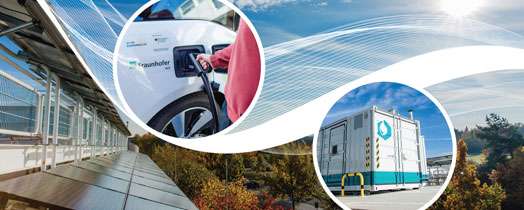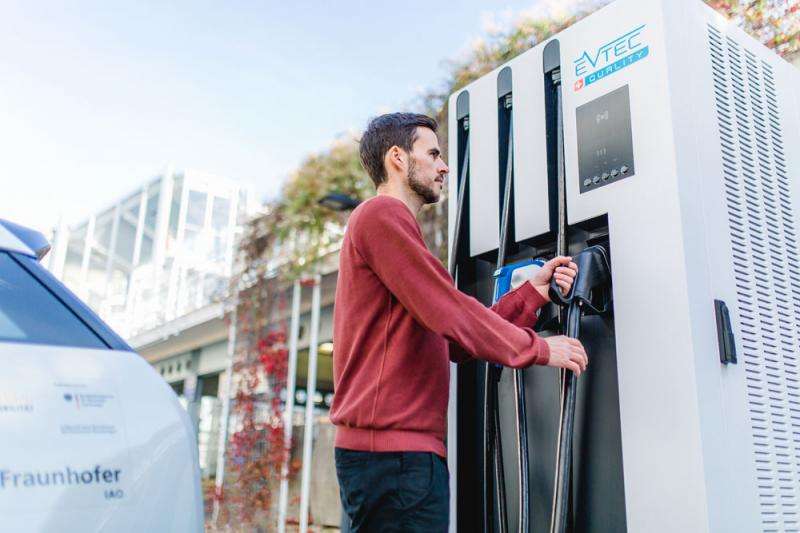Local grid solution for global energy transition

What will intelligent, decentralized energy management look like in the future? Using its own Micro Smart Grid and control systems developed in-house, the Fraunhofer Institute for Industrial Engineering IAO is exploring how to efficiently coordinate energy producers, storage systems, and consumers as well as how to test the innovative technologies required. The research parking garage houses 30 charging spots for electric vehicles, Europe's fastest high-speed charging station, as well as Europe's first hydrogen storage system based on LOHC technology.
By the year 2050, the majority of energy in Germany will come from renewable sources such as wind or solar power. This is according to the government's ambitious energy policy goals, which are driven by various well-known reasons: fossil fuels such as oil and gas are running out, becoming more and more expensive and are bad for the environment. The advantages of sustainable energy sources on the other hand are self-evident: they are inexhaustible, help protect the environment and act against climate change, and can offer long-term price stability. But completely overhauling the current energy supply system poses challenges with respect to grid stability and security of supply, which in turn calls for new technologies and scalable solutions. With the Fraunhofer IAO Micro Smart Grid, the institute is pursuing a decentralized approach to the coordination of energy production and consumption. It therefore guarantees local security of supply and a grid-friendly connection to superordinate power grids. Merging multiple micro smart grids in the future will allow energy systems to be integrated into a larger smart grid in a gradual process that keeps pace with demand.
Parking garage serves as "living lab" for decentralized energy systems
Using the institute's facilities, the research team can apply the local situation to "play out" and test future smart energy management solutions already today. This takes place in the parking garage at the Fraunhofer Institute Center in Stuttgart and the "players" are the various energy producers, storage systems and consumers on the research site. These include a charging infrastructure for electric vehicles with over 30 charge spots, as well as several direct current quick-charging stations with up to 150 kW of power per vehicle. The entire vehicle power supply is produced by a photovoltaic system located on the roof of the parking structure. A lithium-ion battery storage system achieves the best possible balance between differences in energy production and consumption. What is special about this setup is that all components are operated under scientific supervision and real-life conditions. "The centerpiece of our Micro Smart Grid is the energy management system we developed ourselves," explains project manager Florian Klausmann. "This system gives us the means to manage and monitor all energy providers, storage systems and consumers within the context of a variety of optimization goals."

Having real-life data makes it possible for the research team to test various application scenarios in a realistic setting. The system will also allow them to use simulation interfaces to evaluate potential future operating models featuring, say, dynamic electricity pricing or forecast-based facility management. "Companies and municipalities benefit from higher supply reliability and the ability to offset peak loads. For energy providers, micro smart grids could help ensure grid stability or even present an alternative to grid expansion," says Prof. Wilhelm Bauer, director of Fraunhofer IAO.
Europe's first LOHC energy storage unit and fastest high-speed charging station
Another important part of the transition towards a new energy economy is harnessing innovative technologies. A brand-new feature of the Fraunhofer IAO Micro Smart Grid is Europe's first hydrogen storage system based on LOHC (liquid organic hydrogen carrier) technology. This technology bonds hydrogen molecules within a carrier oil, eliminating the need for expensive pressure storage solutions or refrigeration units for liquid hydrogen. With 2000 kWh of storage capacity, the LOHC system constitutes a viable long-term storage option for the Micro Smart Grid, connected to the power supply via a fuel cell. So when it comes to the massive energy surpluses we can expect in the course of the energy transition, LOHC storage will mean that renewable energy production doesn't have to be curtailed.
Fraunhofer IAO unveiled these new features to the public at the "Micro Smart Grid: Innovative Energy Systems in Practice" event on November 9, 2016. With over 30 charge spots and Europe's fastest high-speed charging station, Fraunhofer IAO's Micro Smart Grid is one of largest charging infrastructure facilities ever installed in a parking structure. At the end of the presentation, institute director Prof. Bauer invited the public to make use of this opportunity. "The Micro Smart Grid is also a significant milestone on the path to emission-free, networked and electric mobility. Through our research, we are helping companies and municipalities to integrate these innovative forms of mobility into existing vehicle fleets and the energy system that underpins them."
Provided by Fraunhofer-Gesellschaft





















